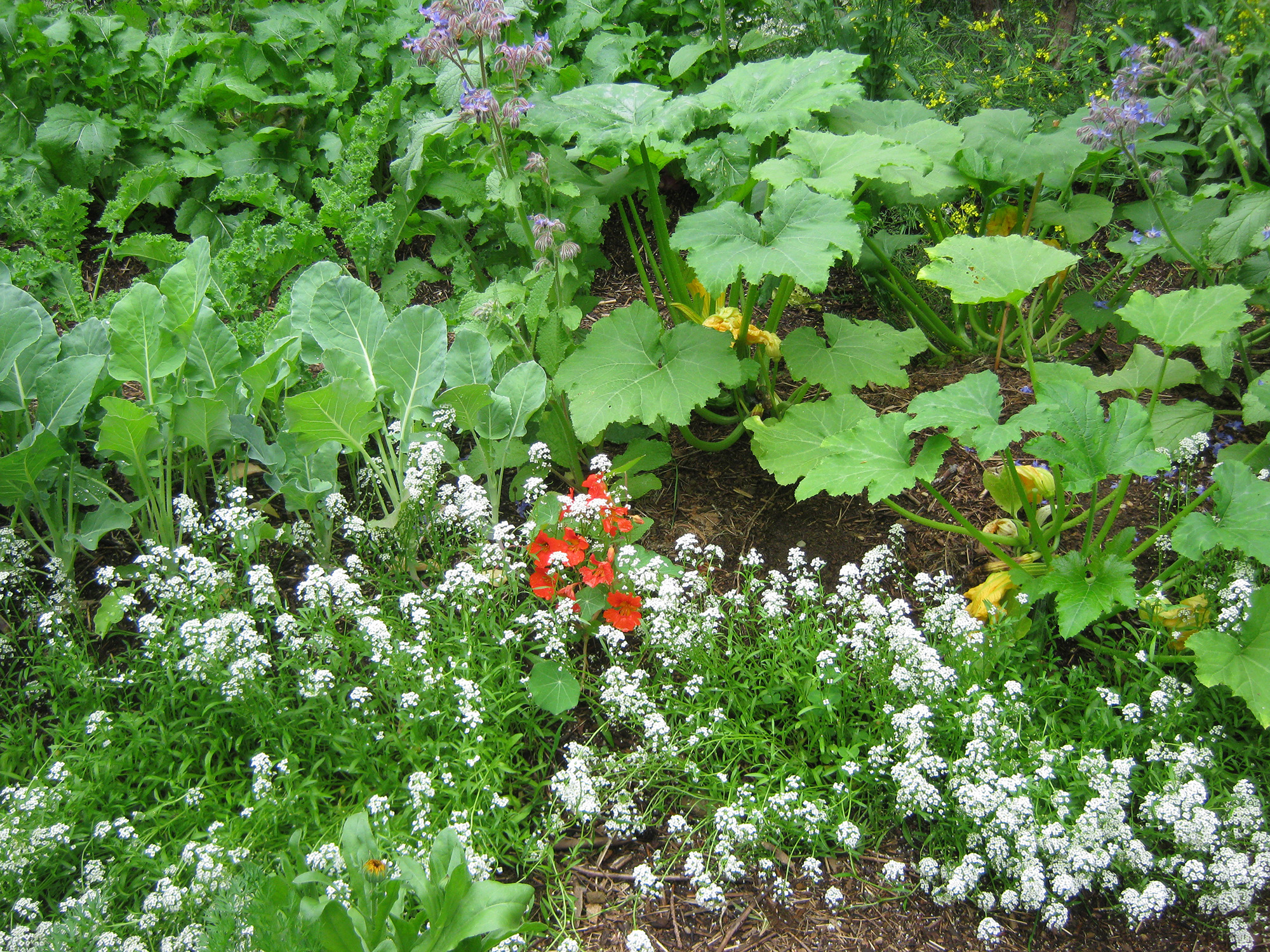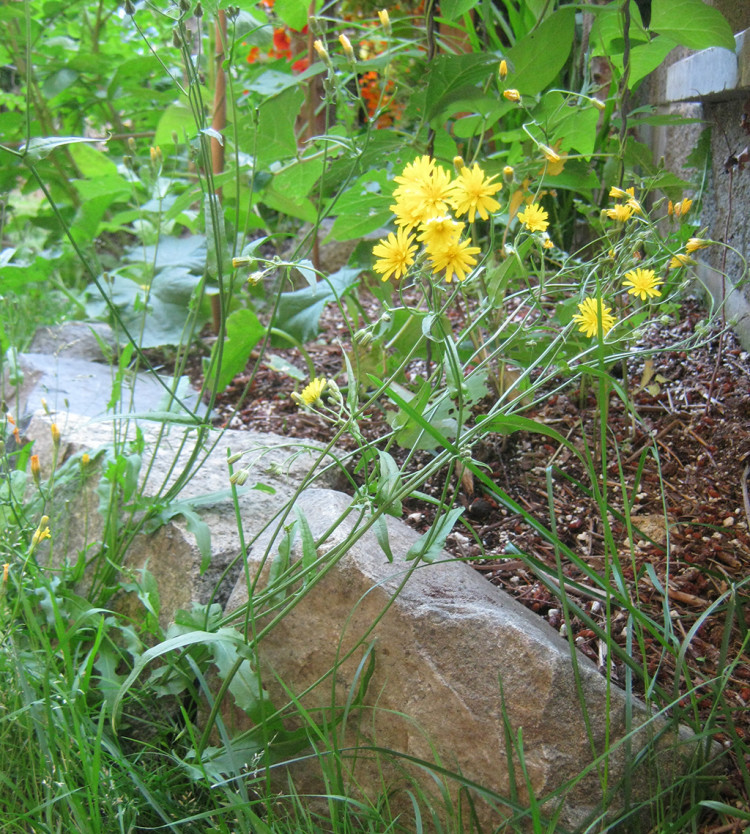There was a time when a conversation about weeds was generally about what chemical worked best to get rid of them. But the times they are a changin’. Slowly, but they are changin’.

These days, weeds are starting to be seen more and more as helpful plants in the garden; not to mention edible or medicinal for humans and animals.
Weeds serve another purpose for the gardener – they can indicate soil condition, and help you figure out what nutrients your soil is lacking.
You can learn to ‘read the weeds’, to help you create healthy soil for your garden. And not only do the weeds indicate what your soil needs, they can also help by adding in the nutrients they have accumulated if you use them as mulch, or in the compost.

A weed is a weed is a weed…or is it?
By now, you must have heard this definition of ‘weeds’: a weed is just a plant growing where you don’t want it. Many plants – even plants that we plant on purpose – can become ‘weedy’, meaning, they get out of control and take over the area they are growing in.
Emerson wrote, “What is a weed? A plant whose virtues have not yet been discovered.” I think that’s a beautiful definition.
Plants that propagate by root, tubers or runners can really get away from you if you’re not careful. Comfrey, Jerusalem artichoke, and mint are some potentially weedy plants that many gardeners are familiar with.
But there are many common weeds that gardeners have come to recognize as helpful in the garden. They can be deep-rooted plants that break up hardpan soils; or perhaps they act as a trap crop for garden pests.
Some plants are known to accumulate nutrients, which they release when cut and used in the compost, or put directly in the garden as mulch.
And all weeds have the potential to indicate what kind of soil the gardener is dealing with. Whether it’s a nutrient deficiency, or the soil structure, these weedy soil indicators can help us to create healthy garden soils.

The weeds and their super powers
Different climates have different weeds; or the same weeds, but with different names. But you can find the same types of plants everywhere.
You can find plants with big taproots that break up hard soils and bring nutrients up from lower down; and you can find plants with a web of shallower roots that will help hold loose soils together.
So if you live somewhere that has different weeds than those listed here, just do some research and find these types of plants that grow in your area.
The following is just a sampling of helpful plants that you can use to either ‘read’ the soil, or to add nutrients to the soil by composting it, or using it as mulch.

Types of weeds
Roots can tell a lot about a plant; and the plant can tell you about your soil.
Tap-rooted plants
Some plants have a long thick root that reaches down a foot more into the soil. This root is called a taproot, and it provides a few benefits to your soil.
The presence of these long tap-rooted plants is an indication that your soil is compacted. This taproot is very strong, and its job is to push its way through clay or compacted soil, enabling water and oxygen to enter. They help to break the soil up, and feed soil organisms when their roots decay.
Plants with long taproots also have the potential to reach nutrients that aren’t available to shallow-rooted plants. These plants have been dubbed ’dynamic accumulators’, and can add nutrients to the garden. They also have the potential to access water from deep down.
Examples of weeds with long taproots are:
- dandelion
- burdock
- plantain
-

Ah, the ever-present dandelion. Maligned and sprayed and pulled, and she just keeps coming back. Dandelion is not only an excellent weed for chop and drop, it is a very nutritions weed, and the whole plant is edible.
Shallow rooted weeds
Plants with shallow roots indicate loose, sandy soils that benefit from the roots holding it together, and preventing erosion. They can also shade the soil and prevent evaporation during drought:
- ground ivy
- purslane
pH balance
Did you know, plants can indicate the pH balance of your soil? That’s pretty handy, right?
Plants that can indicate an acidic soil are:
- plantain
- sheep sorrel
- dockweed
Plants that can indicate an alkaline soil are:
- goosefoot
- true chamomile

You can use these indicators to choose which plants to grow; or you can change the pH of the soil to accommodate the plants you want to grow.
Fertility
These are the weeds that can indicate low fertility in the garden:
- creeping charlie
- clover
- yarrow
- mullein
These plants indicate high fertility:
- chickweed
- lamb’s quarters
- foxtail
- mallow
- plantain

Compacted soil
These are some of the weeds that can indicate compacted soils:
- dandelion
- plantain
- chickweed
Drainage
These plants are good indicators of soil that has poor drainage:
- bindweed
- chickweed
- creeping charlie
How weeds benefit your soil
Many weeds are beneficial when added to the compost, or used as chop-and-drop mulch in the garden. The best ones are those with a long tap root, which can access nutrients deep in the soil and bring them up into their leaves.
When the plant dies down, it releases those nutrients back into the soil in a bioavailable form. What better way to add essential elements into the soil than using the weeds that we pull from the garden?
Keep in mind, though, that weeds propagate from roots and seeds. Don’t put those in the compost unless you are a really good composter, and can get the temperature high enough to kill those roots and seeds.
The following are just four of the many potentially beneficial weeds that can add needed nutrients to your compost, and greatly benefit the garden.
They all have taproots, which aerate compacted soil, create waterways into heavy soils, and reach deep down to find available nutrients:
- Dock – trace elements, potassium, magnesium
- Dandelion – calcium, potassium, trace elements
- Plantain – calcium, trace elements
- Yarrow – potassium, calcium, magnesium, copper

Cultivating a relationship with weeds
I have dock, plantain, dandelion, chickweed, and various other weeds in my garden. And it doesn’t bother me in the least. I keep cutting the leaves and adding them to my compost, or using them as chop-and-drop; and the plantain acts as a great ground cover, shading the soil of the paths.
And I NEVER use chemicals of any kind. Not even the vinegar and dish soap method that I’ve read about. That just doesn’t sound like something I want to pour on my soil. I dig and pull and mulch my weeds.
If a ‘weed’ is growing in a spot where I want to grow something else, I will remove it. But if it is growing in the paths, or somewhere out of the way, I will let it be.
UNLESS it is bindweed or creeping buttercup. Those get ripped out by their evil roots, and thrown in a natural depression in the woods behind the property, where they will hopefully compost.
So, yes, there are weeds that I consider to be ‘weedier’ than others. But as a general rule, I find that the weeds and I can coexist, as long as they don’t get too rambunctious.
I hope that this article has taught you a little bit about how weeds can actually be a benefit to the garden, and don’t always need to be eradicated.
Drop me a note, and let me know how you take care of the weeds in your garden – or if you let the weeds help you take care of your garden.
Health, Hope & Happiness
Tracy



